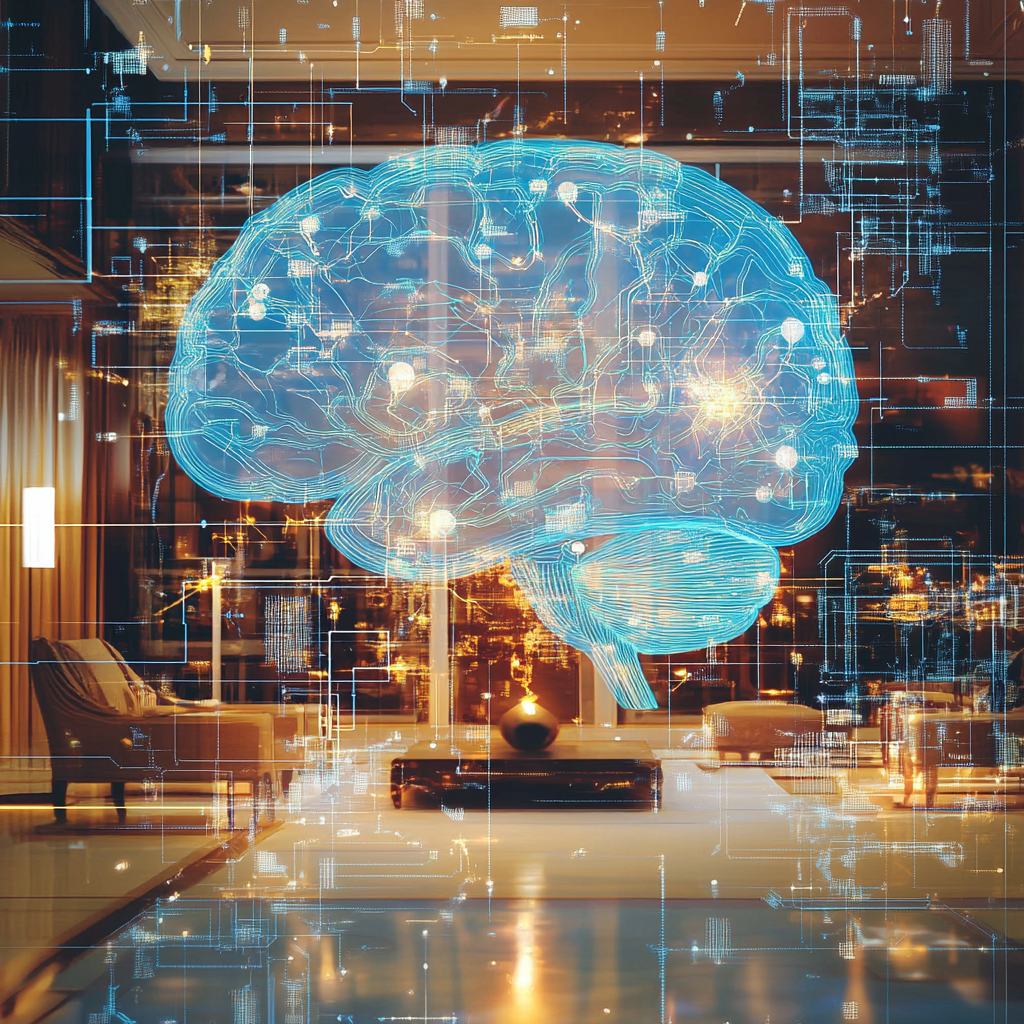Introduction
A guest returns to their room after a long day of meetings, ready to unwind with some television, only to find the TV won't turn on. Traditionally, this scenario unfolds in one of two ways: the guest calls the front desk, waits for maintenance to arrive (potentially delaying their evening plans), or simply gives up and adds another item to their mental list of disappointments. Either way, the result is suboptimal for both the guest and the hotel.
But what if there was a third option—one where guests could solve simple technical issues themselves in under a minute, with intelligent guidance that feels like having a helpful staff member right in the room?
This vision is now becoming reality as AI-powered guest troubleshooting systems transform the hotel maintenance experience. By providing intelligent self-service options for common room issues, hotels are simultaneously enhancing guest satisfaction, optimizing staff efficiency, and gathering valuable operational insights.
The Maintenance Request Challenge
The maintenance challenge in hotels is a familiar pain point for both operators and guests. Simple issues—TVs not working, room temperature problems, wifi connectivity challenges, or door locks behaving erratically—create a disproportionate operational burden while negatively impacting the guest experience.
The traditional maintenance request process involves multiple inefficient steps:
- The guest identifies a problem and contacts the front desk
- Front desk staff create a maintenance ticket and notify the maintenance team
- Maintenance staff must prioritize the request among other duties
- The maintenance person travels to the room, often waiting for the guest to grant access
- Simple troubleshooting steps are attempted (checking connections, resetting devices)
- If resolved, the maintenance person returns to other duties; if not, further diagnosis begins
This process creates several challenges:
- Front desk staff are diverted from other guest service responsibilities
- Maintenance personnel spend significant time traveling between rooms
- Guests experience frustrating waits for assistance
- Hotels incur labor costs for issues that often have simple solutions
- Guest satisfaction suffers due to delays and disruptions
Most telling is that many of these maintenance requests are resolved through basic troubleshooting steps that could be self-guided—checking if devices are plugged in, pressing reset buttons, or toggling input sources.
This insight reveals a significant opportunity: empower guests to resolve simple issues themselves while reserving valuable staff time for truly technical matters.
Traditional Maintenance Request Process
Guest Identifies Issue
Guest discovers a problem with room equipment (TV, HVAC, etc.)
Contact Front Desk
Guest calls front desk to report the issue
Create Maintenance Ticket
Front desk logs the issue and creates a maintenance request
Maintenance Notified
Maintenance team receives the request and prioritizes based on workload
Travel to Room
Maintenance staff travels to guest room, often waiting for guest availability
Troubleshoot Issue
Maintenance performs basic troubleshooting steps to identify and fix the problem
Issue Resolution
Problem is fixed, ticket is closed, and maintenance staff moves to next task
The AI-Powered Solution
Advanced AI platforms like CordiantOne's Cognitive AI are now offering sophisticated self-service troubleshooting capabilities that transform the maintenance experience for both guests and staff.
Here's how the AI guest troubleshooting experience typically works:
- Multiple Access Points - Guests can initiate troubleshooting through their preferred channel: scanning a QR code in the room, sending a text message, speaking to an in-room voice assistant, or using the hotel's mobile app
- Intelligent Issue Identification - The AI asks clarifying questions to precisely identify the problem: "Is the TV not turning on at all, or is it on but showing no picture?"
- Step-by-Step Guidance - Based on the specific issue, the system provides clear, easy-to-follow instructions: "Let's check if the TV is properly connected. Can you verify the power cord is securely plugged into both the TV and wall outlet?"
- Visual Aids - Where helpful, the system provides images or videos demonstrating the troubleshooting steps
- Escalation When Necessary - If self-service steps don't resolve the issue, the system automatically creates a detailed maintenance ticket with all troubleshooting steps already attempted, eliminating redundant efforts
- Resolution Confirmation - The AI follows up to confirm whether the issue was resolved, capturing valuable data on solution effectiveness
- Continuous Learning - The system learns from each interaction, improving its troubleshooting recommendations based on successful resolutions
This approach delivers immediate benefits for both guests and hotels. Guests gain instant assistance without waiting, while hotels optimize their maintenance operations by focusing staff time on issues that truly require human expertise.
The Self-Service Advantage
AI-guided troubleshooting transforms maintenance from a staff-dependent service to an on-demand capability available 24/7, regardless of staffing levels or time of day.
CordiantOne's Cognitive AI: Setting a New Standard in May 2025
CordiantOne's upcoming Cognitive AI platform, scheduled for release in May 2025, represents a significant advancement in this space. While many current solutions offer basic troubleshooting via decision trees, CordiantOne's platform introduces several game-changing capabilities:
1. Visual Recognition Diagnostics
Using the guest's smartphone camera, CordiantOne can visually inspect equipment to identify issues invisible to guests—like a partially depressed reset button or an incorrectly seated HDMI cable. This reduces guesswork and accelerates resolution.
2. Predictive Issue Resolution
By integrating with the hotel's property management and preventative maintenance systems, CordiantOne can anticipate likely issues based on equipment age, maintenance history, and common failure patterns. For example, it might proactively ask "Are you having trouble with the hot water in the shower?" if similar rooms have reported issues.
3. IoT Integration
For hotels with connected room technology, CordiantOne can directly interface with smart devices to run diagnostics, restart systems, or adjust settings without requiring guest intervention.
4. Multi-Step Adaptive Troubleshooting
Unlike basic systems that follow rigid scripts, CordiantOne adapts its approach based on guest responses, equipment specifics, and historical success rates of different troubleshooting approaches.
5. Root Cause Analysis
The platform doesn't just solve immediate problems—it identifies underlying issues. If multiple guests struggle with TV inputs, the system might recommend clearer labeling on remote controls or simplifying the default setup.
6. Maintenance Team Integration
When issues require staff intervention, CordiantOne doesn't just create a ticket—it provides maintenance staff with complete diagnostics and suggests specific tools or parts to bring, maximizing first-visit resolution rates.
7. Guest-Adaptive Communication
The system tailors its communication style based on the guest's apparent technical proficiency, offering more detailed guidance for those who seem less tech-savvy and more efficient instructions for technically confident guests.
For hotel operators, these capabilities translate to meaningful operational improvements and enhanced guest experiences.
CordiantOne AI Troubleshooting Workflow
1. Guest Initiates
Guest encounters issue and starts troubleshooting via app, QR code, or voice command
2. CordiantOne AI Processing
AI analyzes the issue using 5 advanced capabilities
3. Decision Point
AI determines if issue can be solved via self-service or requires staff
4A. Self-Resolution
Guest resolves issue with AI guidance, no staff intervention needed
4B. Staff Escalation
For complex issues, AI creates detailed ticket with diagnostics already performed
5. Continuous Learning
AI learns from resolution data to improve future troubleshooting
CordiantOne AI Capabilities
Visual Recognition
- Identifies equipment models
- Diagnoses connection issues
- Spots misconfigurations
- Guides with visual cues
Predictive Solutions
- Anticipates common issues
- Uses equipment history
- Suggests likely fixes first
- Considers environmental factors
IoT Integration
- Interfaces with smart devices
- Runs remote diagnostics
- Resets systems automatically
- Monitors real-time performance
Adaptive Workflow
- Adjusts to guest tech skill
- Changes path based on responses
- Follows success probability
- Customizes instruction detail
Root Cause Analysis
- Identifies underlying issues
- Suggests preventative fixes
- Flags recurring problems
- Learns from resolution patterns
Traditional Process
CordiantOne AI
The Impact: Benefits of AI-Powered Troubleshooting
AI-powered troubleshooting creates multiple advantages for hotels that implement this technology:
Immediate Guest Resolution - Guests can resolve many common issues instantly, eliminating wait times and frustration. This immediacy transforms what could be a negative experience into a demonstration of the hotel's commitment to guest empowerment and service.
Staff Optimization - Maintenance personnel can focus on complex, value-added tasks rather than routine troubleshooting. This both improves operational efficiency and creates more meaningful work for skilled team members.
Reduced Room Entry - Many guests prefer not having staff enter their rooms for minor issues. Self-service troubleshooting respects guest privacy while still providing assistance.
Consistent Experience - AI guidance ensures that every guest receives the same high-quality troubleshooting assistance, regardless of which staff member is on duty or how busy the hotel is at that moment.
Operational Intelligence - The data collected through troubleshooting interactions provides valuable insights into common issues, equipment performance, and maintenance patterns that can inform preventative maintenance and purchasing decisions.
Scalable Support - During high-occupancy periods or staffing shortages, the system continues to provide consistent service without degradation, maintaining service levels that would be challenging with human-only support.
Language Barriers Eliminated - Multi-lingual AI support ensures international guests receive the same quality of assistance as native language speakers, eliminating communication challenges that often complicate maintenance requests.
Continuous Improvement - Each troubleshooting interaction makes the system more effective as it learns from successful resolutions and refines its approach for future guests.
These benefits create value for both the business operations and guest experience sides of hotel management, making AI troubleshooting a uniquely compelling technology investment.
Guest Experience: The Human Element
The guest experience benefits of AI troubleshooting go beyond just fixing problems quickly. The psychological aspects of this approach are equally important:
Empowerment vs. Dependency - Guests feel capable and in control rather than dependent on staff availability for assistance.
Privacy Maintained - For guests who value privacy, resolving issues without staff entry is a significant benefit.
Uninterrupted Plans - Business travelers and guests with tight schedules particularly appreciate not having to wait for maintenance.
Learning Opportunity - Some guests appreciate gaining knowledge about how systems in their room work.
No Awkward Interactions - Issues that might be embarrassing for guests to explain (like confusing bathroom fixtures or entertainment systems) can be resolved privately.
These experiential benefits make AI troubleshooting not just an operational improvement but an enhancement to the overall guest journey.
Future Directions: Where AI Troubleshooting is Heading
As CordiantOne's Cognitive AI platform continues to evolve beyond its May 2025 launch, several emerging capabilities will further transform the guest troubleshooting experience:
Augmented Reality Guidance - Visual overlays on smartphone cameras will show guests exactly where to find components or which buttons to press
Predictive Maintenance - AI will flag failing components based on subtle performance changes before they create guest-facing issues
Environmental Customization - Systems will learn guest preferences and proactively offer adjustments: "I notice you typically keep your room cooler than the current setting. Would you like me to adjust that for you?"
Voice Biometric Authentication - Voice recognition will enable secure troubleshooting for sensitive systems without requiring authentication codes
Multi-Room Coordination - For suites or connecting rooms, troubleshooting will coordinate across spaces for systems that span multiple areas
These advancements will continue to raise the standard for hotel technology experiences, creating greater differentiation between properties that embrace AI and those that maintain traditional maintenance approaches.
Getting Started with AI Troubleshooting
For hotels considering implementing AI troubleshooting capabilities, CordiantOne recommends a five-phase approach:
- Assessment - Analyze maintenance logs to identify the most common simple issues specific to your property
- Pilot Program - Implement troubleshooting for the top 3-5 issues on a limited room subset
- Staff Integration - Train front desk and maintenance teams on the new workflow and how to support guests using the system
- Expansion - Gradually add more troubleshooting capabilities based on success patterns
- Optimization - Use analytics to refine troubleshooting pathways and identify preventative opportunities
This measured deployment ensures both staff and guests adapt comfortably to the new approach while delivering immediate operational benefits.
Conclusion: A Win-Win for Guests and Operators
The future of hotel maintenance is increasingly clear: AI-powered self-service will handle many simple troubleshooting needs, creating immediate resolution for guests while allowing staff to focus on complex issues requiring technical expertise.
As CordiantOne's Cognitive AI platform prepares for its May 2025 launch, hotels that embrace this approach will gain significant advantages in operational efficiency, guest satisfaction, and maintenance intelligence.
The 30-second fix isn't just about resolving technical problems quickly—it's about transforming the entire maintenance experience from a potential point of frustration into an opportunity to demonstrate technological sophistication and guest-centric service.
For forward-thinking hoteliers, the question is no longer whether to implement AI troubleshooting, but how quickly they can deploy it to gain competitive advantage in an industry where both operational efficiency and guest experience define success.



